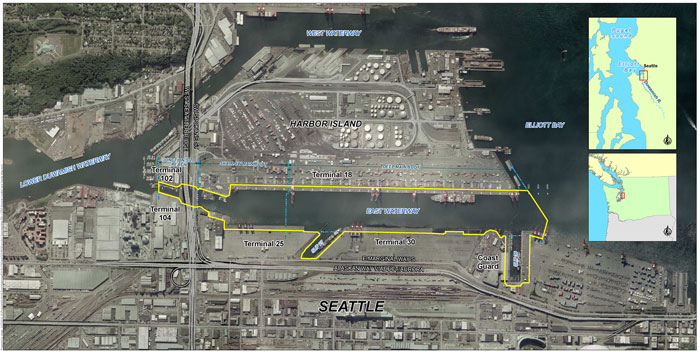The Hanford and Lander Combined Sewer Overflows (CSOs) are two locations identified under the County's 1999 Sediment Management Plan as needing cleanup. The plan evaluated remediation strategies for correcting hazards caused by contaminated sediments near seven King County CSOs. The cleanup project at these sites involves a combination of approaches.
King County and the Port of Seattle removed 19,000 cubic yards of contaminated sediment near the Lander CSO in 2009. The project was part of a berth deepening at Terminal 30 to allow deeper draft container vessels to use the pier. The dredged sediment was transported to a subtitle D landfill for disposal and the exposed sediment surface was sampled to verify that it passed state sediment standards.
The areas near the Lander and Hanford CSOs are being evaluated to determine what additional sediment remediation is necessary as part of the East Waterway Superfund project described below. Once the Superfund Cleanup is completed, the actions needed for the Hanford and Lander sediment remediation project will be complete.
King County plans to build a new 151-million gallon per day (MGD) wet weather treatment facility to control the King St. and Kingdome CSOs into Elliott Bay and the Lander and Hanford CSOs into the East Waterway. The facility’s outfall may be located in either Elliott Bay or the East Waterway. The project is scheduled to be completed by 2030.
Harbor Island Area Superfund Sites, EPA
Harbor Island Area Superfund Sites, EPA
Background (from EPA website):
Harbor Island is an industrial island in Seattle, Washington's Elliott Bay. Built in the early 1900s, the 420-acre island supports businesses that conduct commercial and industrial activities, including ocean and rail transport operations. Site operations contaminated groundwater, sediment and soil with lead and other contaminants. Many Superfund sites like Harbor Island are large and complicated. These sites are often broken up into smaller areas to make cleanup easier and more manageable. These areas are called "Operable Units" or OUs. The EPA divided the site into six OUs, to better address site cleanup. The entire island and associated sediments are designated as the Superfund site. Cleanup decisions have been made at five OUs, and the remaining OU for cleanup is the East Waterway.
East Waterway - Harbor Island Superfund Site
The East Waterway is a portion of the Harbor Island Superfund site, which the US Environmental Protection Agency (EPA) added to its Superfund list in 1983. The EPA is overseeing the cleanup, which will target contamination in sediments and address unacceptable human health and environmental risks in the waterway.
With EPA oversight, the Port of Seattle has already removed over 200,000 cubic yards of contaminated material from the waterway. The Port and EPA studied the waterway to better understand the remaining contamination and risks and to develop a cleanup plan. The Port is partnering with King County and City of Seattle to complete a Remedial Investigation (determines the extent of the chemical contamination and the risks to human health and the environment posed by this contamination) and a Feasibility Study (evaluates various cleanup alternatives to address unacceptable human health and environmental risks). The EPA will then select a proposed cleanup plan for public review, finalize the plan and then will start the cleanup.
The Port, County and City are undertaking source control actions in the drainage basins to identify, trace and reduce chemical inputs to the waterway. The County is also working to control the overflows from the County's Hanford and Lander CSOs.

The East Waterway flows by the east side of Harbor Island that is at the mouth of the Duwamish Waterway on the southern edge of Elliott Bay. Lead smelting, shipbuilding and maintenance, metal recycling, oil terminals and bulk fuel storage facilities, discharge of raw sewage (up until 1958), and other industrial activities contaminated the island or the waterways beside it with polychlorinated biphenyls (PCBs), metals, and other chemicals.
East Waterway (Duwamish) CSOs – Hanford #2 and Lander
The County is planning a CSO control project for Hanford and Lander CSOs.
Both the Hanford #2 CSO, a 48-inch diameter, 150-foot long outfall, and the Lander CSO, which discharges through a 96-inch-diameter outfall, lie under Port of Seattle piers in the East Waterway of the Duwamish Waterway.
These CSOs have overflowed between 8 to 32 times per year since 1991 when monitoring began. In a 1992 project, King County reduced the CSOs' overflow volume by approximately 56 million gallons per year.
Additional control of the Hanford #2 and Lander CSOs
CSOs contain more harmful chemicals and disease-causing pathogens than stormwater alone. Controlling CSOs protects public health and the environment by reducing the threat to people from contact with pathogens and consumption of contaminated fish. It also reduces the threat to salmon that may be exposed to chemicals at their most vulnerable life stage. CSO control ultimately helps meet cleanup goals for the East Waterway and protect Puget Sound.
CSO control is required by Washington state and federal law. “Control” means reducing the number of untreated overflows from each location to the Washington state standard of once per year on average.

 Translate
Translate